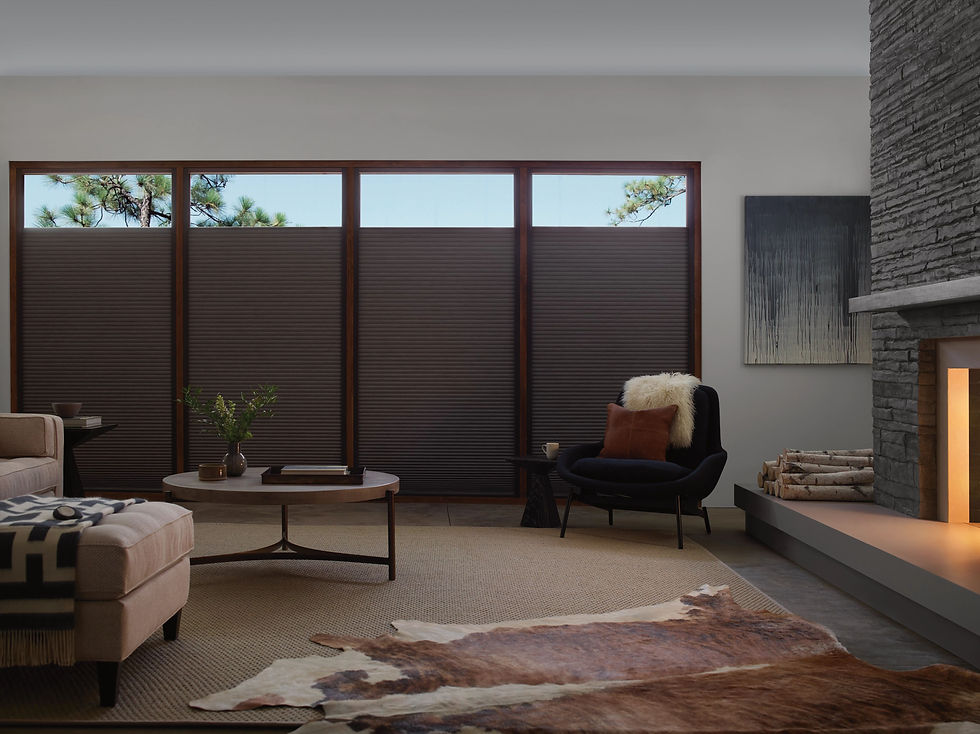How to Avoid Light Gaps in Your Window Coverings: Tips and Techniques
- Dan White

- Feb 28, 2024
- 4 min read

In the realm of home decor, achieving the perfect balance of light control, privacy, and aesthetic appeal can be challenging. One common issue that homeowners face with blinds, shades, and shutters is the presence of light gaps, which can compromise sleep and disrupt the desired ambiance of a room. Fortunately, there are several options available to address this issue effectively. In this guide, we'll explore the use of light-blocking U channels, drapery panels, and day/night shutters to prevent light gaps and enhance your living space.

Understanding Light Gaps In Window Coverings
Before delving into the solutions, it's essential to understand what causes light gaps in blinds, shades, and shutters. Light gaps typically occur due to several factors:
Imperfect Ordering: Poorly measured window treatments may leave larger gaps between the window frame and the treatment itself, allowing light to filter through.
Material Flexibility: Some materials used in blinds and shades, such as vinyl or lightweight fabrics, may not offer sufficient rigidity to block out light entirely, especially when exposed to external factors like wind or movement. An example of this would be vertical blinds and shades that are installed above an air register.
Window Coverings Design: Certain designs of blinds or shutters may inherently have gaps that compromise their light-blocking capabilities.
Not all window coverings can come with light gap mitigation and addressing these factors is crucial to effectively minimizing or eliminating light gaps in your window treatments.
Light-Blocking U Channels
Light-blocking U channels, also known as light blockers or side channels, are a popular solution for minimizing light gaps in blinds and shades. These channels are typically made of durable materials like aluminum and are installed along the sides of the window frame, creating a seamless fit for the window treatment.
The key benefits of light-blocking U channels include:
Enhanced Privacy: By eliminating gaps between the window treatment and the frame, U channels provide enhanced privacy by preventing prying eyes from seeing movement in your living space.
Improved Light Control: With minimal light leakage, U channels offer improved light control, allowing you to create a darker, more conducive environment for activities like sleeping or watching movies.
Energy Efficiency: By reducing light infiltration, U channels can contribute to better energy efficiency by minimizing heat gain in the summer and heat loss in the winter, thereby lowering your utility bills.
It is possible to install aftermarket light blocks on some window shades however the best and cleanest results are achieved when they are ordered with the shades. Many manufacturers offer customizable options to ensure a perfect fit for your windows.
Types of window coverings that come with channels are cellular shades & roller shades.
Drapery Panels
In the video above, Kate Winslet's character is shown enjoying the room darkening effect that is achieved by combining drapery panels with room darkening shades in a bedroom.
Here are some advantages of using drapery panels to address light gaps:
Complete Coverage: Drapery panels can be installed to overlap the edges of shades, effectively concealing any light gaps that may exist.
Versatility: Drapery panels offer versatility in terms of style and functionality. You can choose sheer panels to diffuse light while maintaining privacy during the day or opt for heavier, opaque fabrics for enhanced light blocking at night.
Sound Insulation: In addition to blocking light, drapery panels can also provide sound insulation, helping to reduce noise from outside sources and creating a quieter, more peaceful indoor environment.
When selecting drapery panels, consider the desired level of light control, the style of your existing window treatments, and the overall aesthetic of the room. Customization options abound, allowing you to achieve the perfect balance of form and function.
Day/Night Shutters
Day/night shutters represent a versatile window treatment solution that combines the benefits of shades and shutters in a single design. Shutters are a louvered window treatment which means that some light bleeds around the panels and between the louvers. Day/Night Shutters offer a slim shade that fits behind the shutter frame and can be lowered for a more complete blackout effect.
Here's why day/night shutters are a compelling option for preventing light gaps:
Dual Functionality: With separate panels for day and night, these shutters provide unparalleled flexibility in controlling light and privacy. During the day, you can adjust the louvers or open the daytime panel to let in natural light while maintaining privacy. At night, the nighttime shade can be closed to block out light and ensure complete darkness.
Sleek Design: Day/night shutters offer a sleek, modern design that complements a variety of architectural styles and interior decor schemes. Their clean lines and customizable finishes make them a stylish addition to any room.
Durable Construction: Constructed from high-quality materials such as hardwood or composite, day/night shutters are built to withstand the test of time. Their sturdy construction ensures reliable performance and minimal maintenance requirements.
While day/night shutters may represent a larger upfront investment compared to other window treatments, their versatility and durability make them a worthwhile long-term investment in your home.

Conclusion
Light gaps in blinds, shades, and shutters can detract from the overall beauty and functionality of your living space. By leveraging solutions such as light-blocking U channels, drapery panels, and day/night shutters, you can effectively minimize or eliminate these gaps, enhancing privacy, improving light control, and elevating the aesthetic appeal of your home.
Whether you opt for the sleek sophistication of U channels, the timeless elegance of drapery panels, or the versatility of day/night shutters, investing in high-quality window treatments can transform your windows into focal points of beauty and functionality. With careful consideration of your preferences and requirements, you can create a living environment that reflects your unique style while maximizing comfort and privacy for years to come.




Comments